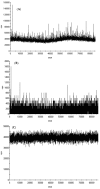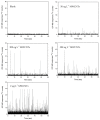Yttrium Residues in MWCNT Enable Assessment of MWCNT Removal during Wastewater Treatment
- PMID: 31052363
- PMCID: PMC6566316
- DOI: 10.3390/nano9050670
Yttrium Residues in MWCNT Enable Assessment of MWCNT Removal during Wastewater Treatment
Abstract
Many analytical techniques have limited sensitivity to quantify multi-walled carbon nanotubes (MWCNTs) at environmentally relevant exposure concentrations in wastewaters. We found that trace metals (e.g., Y, Co, Fe) used in MWCNT synthesis correlated with MWCNT concentrations. Because of low background yttrium (Y) concentrations in wastewater, Y was used to track MWCNT removal by wastewater biomass. Transmission electron microscopy (TEM) imaging and dissolution studies indicated that the residual trace metals were strongly embedded within the MWCNTs. For our specific MWCNT, Y concentration in MWCNTs was 76 µg g-1, and single particle mode inductively coupled plasma mass spectrometry (spICP-MS) was shown viable to detect Y-associated MWCNTs. The detection limit of the specific MWCNTs was 0.82 µg L-1 using Y as a surrogate, compared with >100 µg L-1 for other techniques applied for MWCNT quantification in wastewater biomass. MWCNT removal at wastewater treatment plants (WWTPs) was assessed by dosing MWCNTs (100 µg L-1) in water containing a range of biomass concentrations obtained from wastewater return activated sludge (RAS) collected from a local WWTP. Using high volume to surface area reactors (to limit artifacts of MWCNT loss due to adsorption to vessel walls) and adding 5 g L-1 of total suspended solids (TSS) of RAS (3-h mixing) reduced the MWCNT concentrations from 100 µg L-1 to 2 µg L-1. The results provide an environmentally relevant insight into the fate of MWCNTs across their end of life cycle and aid in regulatory permits that require estimates of engineered nanomaterial removal at WWTPs upon accidental release into sewers from manufacturing facilities.
Keywords: ICP-MS; MWCNTs; RAS; spICP-MS; wastewater treatment; yttrium.
Conflict of interest statement
The authors declare no conflict of interest.
Figures






References
-
- Mohammadzadeh F., Jahanshahi M., Rashidi A. Preparation of nanosensors based on organic functionalized MWCNT for H2S detection. Appl. Surf. Sci. 2012;259:159–165. doi: 10.1016/j.apsusc.2012.07.011. - DOI
-
- Dorraji S., Ahadzadeh I., Rasoulifard M. Chitosan/polyaniline/ MWCNT nanocomposite fibers as an electrode material for electrical double layer capacitors. Int. J. Hydrog. Energy. 2014;39:9350–9355. doi: 10.1016/j.ijhydene.2014.03.242. - DOI
-
- Asmatulu R., Mahmud G.A., Hille C., Misak H.E. Effects of UV degradation on surface hydrophobicity, crack, and thickness of MWCNT-based nanocomposite coatings. Prog. Org. Coat. 2011;72:553–561.
-
- Kuznetzov A.A., Lee S.B., Zhang M., Baughman R.H., Zakhidov A. Electron field emission from transparent multiwalled carbon nanotube sheets for inverted field emission displays. Carbon. 2010;48:41–46. doi: 10.1016/j.carbon.2009.08.009. - DOI
Grants and funding
LinkOut - more resources
Full Text Sources

